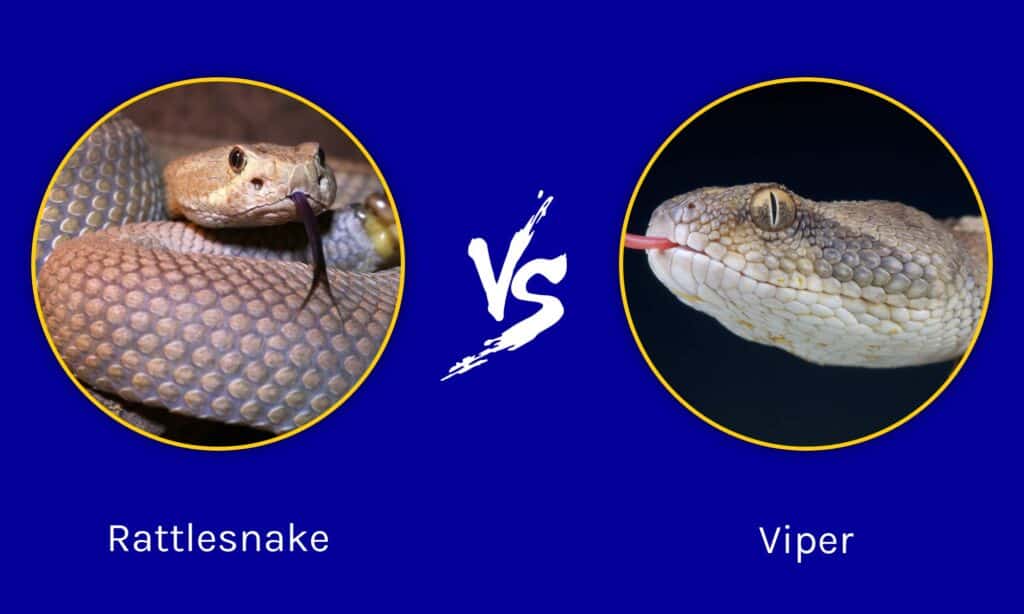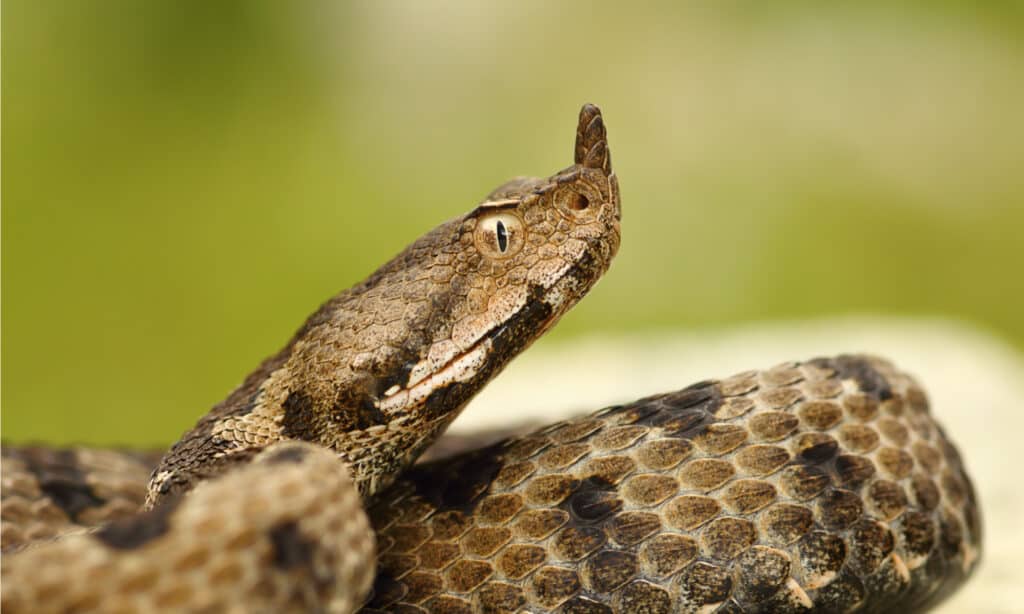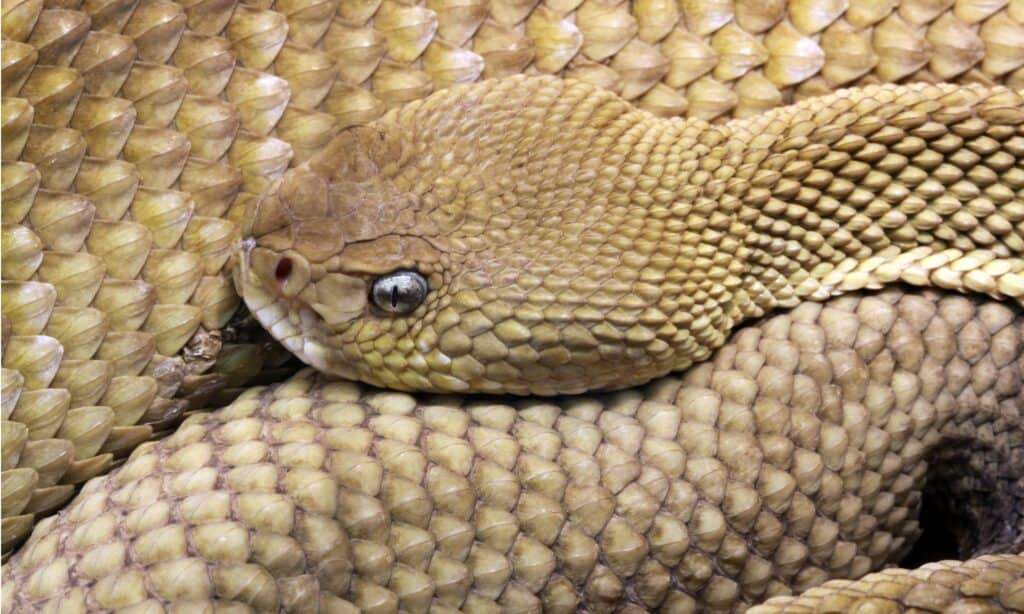Vipers, also known as viperids, are a family of dangerous and venomous snakes. Rattlesnakes, on the other hand, are just one genus of pit vipers; a genus under the viper subfamily. In total, there are three subfamilies in Viperidae.
However, because rattlesnakes are a unique species, they are often compared to the average viper’s features and statistics. This article compares the snake family of vipers to the rattlesnake genus. Find out which snake is more venomous.
Comparing Rattlesnakes and Vipers

| Rattlesnakes | Vipers | |
|---|---|---|
| Taxonomy | Genus of pit viper | Snake family |
| Size | 12 to 96 inches Up to 25 pounds | 7 to 144 inches Up to 10 pounds |
| Location | The Americas | Found all over the world except Antarctica, Hawaii, Madagascar, and Australia. |
| Venom | Primarily hemotoxic | Could be hemotoxic, neurotoxic, cytotoxic, proteolytic, or a combination |
Rattlesnakes vs. Vipers: Taxonomy
Rattlesnakes
Rattlesnakes are species of pit vipers. They are venomous snakes that get their names from their keratin rattles which are attached to their tails. Apart from Massasauga rattlesnakes (pronounced mass-a-saw-ga) that have very small rattles, most rattlesnakes can be heard even before you see them.
There are about 56 species of rattlesnakes and between 65 and 70 subspecies- all of which are found in the Americas. Since rattlesnakes are pit vipers, they have infrared pits that allow them to detect the presence and movements of these venomous snakes.
Vipers
Vipers are a snake family known for their sharp solenoglyphous fangs and toxic venoms. They are known for giving live birth, also called ovoviviparity. Unlike other snakes that lay eggs, vipers allow their young to develop inside of them and only give birth when they are fully developed.
They are known for their long solenoglyphous fangs, which are the longest of the three fang types (solenoglyphous, opisthoglyphous, and proteroglyphous fangs).
Rattlesnakes vs. Vipers: Size

Rattlesnakes grow between 12 to 96 inches while vipers measure a minimum of 7 inches and a maximum of 144 inches.
©iStock.com/Shoemcfly
Rattlesnakes
Rattlesnakes grow between 12 to 96 inches and weigh up to 10 pounds. The shortest rattlesnake known is the pygmy rattlesnake which measures from 12 to 24 inches. On the other hand, eastern diamondback rattlesnakes are the longest subspecies and grow up to 33 to 96 inches. Like all vipers, they have triangular heads and elliptical pupils.
Vipers
Pit vipers vary in size and length. The shortest known pit viper is the dwarf adder which ranges from 7 to 10 inches, while the longest pit viper is the bushmaster which grows up to 144 inches (12 feet). Almost all vipers have triangular heads and elliptical pupils. Generally, vipers are known to attain a maximum weight of 25 pounds.
Rattlesnakes vs. Vipers: Location

Rattlesnakes are found all over the Americas, while vipers are found worldwide.
©taviphoto/Shutterstock.com
Rattlesnakes
Rattlesnakes are found in a wide range of locations, including North America, South America, Central America, Greenland, and the Caribbean.
Vipers
Vipers are found all over the world except in Antarctica, Hawaii, Madagascar, Australia, and a handful of other small islands that are abandoned.
Rattlesnakes vs. Vipers: Venom

Most rattlesnakes have hemotoxic venom, but vipers’ venom varies.
©iStock.com/Ben185
Rattlesnake
Rattlesnakes have primarily hemotoxic venom. Hemotoxins attack the circulatory system, cause breathing difficulties, and cause or hinder blood clotting. They also attack the muscle tissue. With extremely toxic species, a bite can lead to blood vessels rupturing, leading to heavy bleeding. In more toxic species, their bites can lead to the death of cells in the affected areas.
Vipers
Viper venom contains several components that vary by species. Some species’ venoms contain hemotoxins, neurotoxins, proteolytic enzymes, and cytotoxins. Neurotoxins affect the nervous system and can cause paralysis. Proteolytic venom attacks the victim’s tissue, while cytotoxic venom destroys the tissue’s cell membrane, leading to the cell’s destruction.
Which is More Venomous: Rattlesnakes vs. Vipers?
In order to get an accurate answer to this question, let’s consider the most venomous rattlesnake species versus the most venomous viper. Let’s get started.
Most Venomous Rattlesnake: Mojave Rattlesnake Crotalus scutulatus
The Mojave rattlesnake is recognized as the rattlesnake with the most venomous bite. (Note that the tiger rattlesnake has the most toxic venom, but due to its low venom yield, it isn’t recognized as the most venomous.)
The Mojave rattlesnake’s maximum venom yield is debated, but they can likely inject 50 to 150mg of venom per bite. The average lethal dose of the venom is 0.08mg/ pound (0.18mg/ kg). This means a person weighing 150 pounds could be killed by only 12 mg of the Mojave rattlesnake’s venom. Since it can produce 150 mg in a bite, a Mojave rattlesnake’s venom is strong enough to kill up to 12 humans with one bite.
Most Venomous Viper: Saw-Scaled Viper (Echis carinatus)
The saw-scaled viper is known as the most venomous viper in the world. This viper’s venom contains neurotoxins, hemotoxins, cytotoxins, and cardiotoxins.
The amount of venom yield differs based on the specimen’s size; however, it is generally between 10 to 70 mg. According to research studies, only 5mg of this snake’s venom is enough to kill a healthy human. Considering its maximum venom yield, the snake is strong enough to kill 14 people. In addition, saw-scaled vipers never inject less than 10 mg of venom per bite.
Considering both species’ venoms, it is safe to say that rattlesnakes aren’t more venomous than vipers. Also, since rattlesnakes are of the Viperidae family, if they were the most dangerous vipers, they would be known as the most venomous rattlesnake as well as the most venomous viper.
What To Do If You Get Bitten By A Venomous Snake
If you get bitten by a venomous snake, do not let their lethal venom dosages scare you. Remember that the presence of anti-venom changes things greatly. Here is a simple list to follow in the event of a venomous snake bite.
- Contact emergency services immediately.
- Remove constrictive clothing and jewelry.
- Keep the affected body part below the heart.
- Sit still and wait.
Although this list might look simple, it is important that you do exactly this and nothing more. This is because movements will help the venom circulate faster, bringing it closer to your heart, which can be fatal.
The photo featured at the top of this post is © iStock.com/taviphoto
Discover the "Monster" Snake 5X Bigger than an Anaconda
Every day A-Z Animals sends out some of the most incredible facts in the world from our free newsletter. Want to discover the 10 most beautiful snakes in the world, a "snake island" where you're never more than 3 feet from danger, or a "monster" snake 5X larger than an anaconda? Then sign up right now and you'll start receiving our daily newsletter absolutely free.
Thank you for reading! Have some feedback for us? Contact the AZ Animals editorial team.






